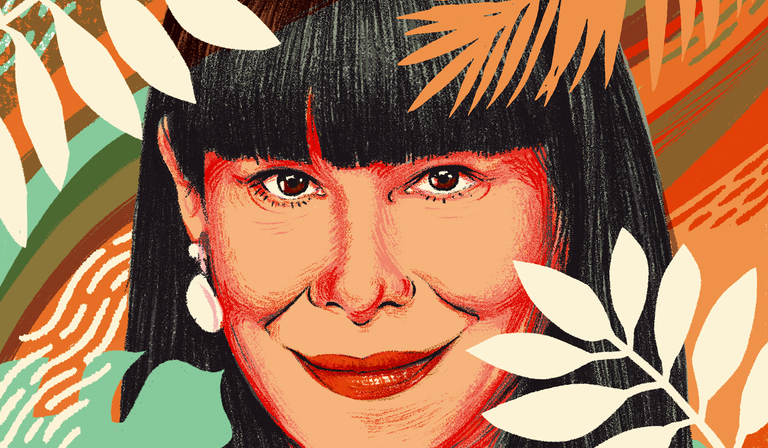When the barrister Monica Feria-Tinta was a child, she couldn’t speak to her grandmother. “I, who grew up in Lima, never learned Quechua, so I never properly spoke to her,” she writes in her new book, A Barrister for the Earth. “I admired her rebellious dismissal of a culture that had come to oppress the Andean world, that had come to oppress her.”
Feria-Tinta, however, grew up fully assimilated into the oppressor’s culture. She spoke Spanish, studied law in Peru, then trained in England to become a barrister specialising in international law. In 2000, she became the first Peruvian lawyer to receive the prestigious diploma from the Hague Academy of International Law. She used that training to represent Indigenous people, rivers, a forest and whole ecosystems, as she describes in her book.
She’s not alone. Over the past decade, a growing number of ordinary people have resorted to the courts to protect the natural world. The Whanganui River, in New Zealand, was in 2017 one of the first entities to be recognised as a legal living entity after a 160-year campaign by the Māori people. Other campaigners have battled for legal personhood for forests, rivers and even trees. In the UK, a movement is afoot to protect ancient trees after the felling of both a 500-year-old oak by the pub chain Toby Carvery earlier this year and the Sycamore Gap tree in 2023.
Feria-Tinta’s biography suggests a fully paid-up member of the establishment, but, when I meet her at her London chambers, I’m struck by the juxtaposition of the law firm and the lawyer. The meeting room is typical of its kind: muted tones, minimalist design, with a large, formal boardroom table. But Feria-Tinta welcomes me with warmth, wearing a colourful shawl over a strapless, floaty dress evocative of her South American heritage. She appears the physical embodiment of an integration of two seemingly disparate cultures, and indeed that is how she sees her work.
“Certainly, to bring the climate into the courtroom is a major turning point. It was not easy at all, and the courts delivered crucial, crucial, breakthroughs,” she tells me. “The purpose of the book is to show that the law has a great role, and it can be very powerful.”
Feria-Tinta tells me the UK is beginning to use the law to protect cherished rivers and trees. She helped draft the Rights of the River Ouse Charter after being contacted by the Environmental Law Foundation, which worked closely with the local group Love Our Ouse. That river now joins a group of other rivers recognised as “living entities” with “intrinsic rights to exist”.
It seems people are waking up to the reality that if we don’t fight to protect nature now, it may be too late
As the natural world collapses around us, it seems people are waking up to the reality that if we don’t fight to protect nature now, it may be too late. A number of recent books address the issue. The nature writer Robert Macfarlane dives deep into rivers in his Is a River Alive?. Last year, the Turkish novelist Elif Shafak wrote about rivers as metaphor for human interconnectedness in There are Rivers in the Sky. A few years before that, the religious historian Karen Armstrong’s Sacred Nature explored how we have lost a once universal belief in nature as divine.
“We have to change not only our lifestyle but our whole belief system,” Armstrong wrote. “We have ransacked nature, treating it as a mere resource, because over the last 500 years we have cultivated a worldview that is very different from [that of] our forebears.”
Nearly all early and Indigenous religions shared a sense of the inherent divinity of nature. As Armstrong writes, “The fact that for most of history people in different parts of the world developed such a remarkably similar conception of this sacred reality suggests that it may be an archetypal notion embedded in the human psyche.”
In the 6th century BCE, Lao Tzu, the thinker generally regarded as the founder of Taoism, described the dao as the sacred principle of nature—an ineffable energy that pervades all life, harmoniously linking plant, animal, human and divine worlds and enabling them each to fulfil their potential. The ancient Indian Upanishads described the interconnectedness of nature, the self (Atman), and ultimate reality (Brahman). For them, nature was not separate from the divine but a manifestation of it. Other religions anthropomorphised sacred nature as a female goddess: Inanna, Astarte, Isis, Oshun, Kali, Gaia.
It was the Hebrew Bible (largely synonymous with the Old Testament) that deposed nature, since it saw the divine in human events. Its god was a jealous god, singular and male. Genesis lays out the new world order: “Be fruitful, multiply, fill the earth and conquer it. Be masters of the fish of the sea, the birds of heaven and all living animals on earth.” Nature was no longer supreme and sacred, a living revelation of the divine. It was a commodity to be conquered, extracted, exploited for man’s benefit.
Armstrong describes how “the sacrality of nature … this primal way of life has survived only in a few remaining communities of Indigenous tribal peoples”. It is in defending those Indigenous peoples—and nature itself—that Feria-Tinta found her calling. She has become one of the pre-eminent practitioners in an area of law called Earth jurisprudence. She relates 10 of her most important cases in her book.
There are the Torres Strait Islanders, whom she represented in a landmark case before the UN human rights committee. In a 2022 ruling, Australia was found responsible for violating the Islanders’ human rights owing to its lack of action on climate change.
Working for the World Wide Fund for Nature, she helped bring about another historic finding in the little-known International Tribunal for the Law of the Sea, which ruled that states have a legal obligation to protect the oceans and marine biodiversity from climate change. “For that tribunal of 21 judges to say that greenhouse gas emissions constitute pollution for the sea, that is massive,” she tells me. “Maybe not for the average person; but as a lawyer, I can see the impact.”
She explains how the ruling could be used in the UK against industrial chicken farms, for example, as the waste of 20m chickens has led to “dead zones” along the River Wye as phosphate pollution and algal blooms kill entire ecosystems. Other river catchment areas in Norfolk, Shropshire, Gloucestershire, Yorkshire, Lincolnshire, Herefordshire and Powys face similar problems.
Her most famous case came five years ago, when she represented the Ecuadorian cloud forest known as Los Cedros. A Canadian mining company had been granted a concession to begin exploration in this pristine nature reserve because the Ecuadorian government held the view that, as no humans lived there, consultation was unnecessary. Yet the tropical Andes of Ecuador top the list of biodiversity hot spots for vertebrate species, endemic vertebrates and endemic plants. The primeval forest of 12,000 acres safeguards the sources of four watersheds, and within its boundaries are hundreds of species at high risk of extinction, five of which are critically endangered, including the brown-headed spider monkey, the jaguar and the Andean spectacled bear—the inspiration for Paddington Bear. It is also a museum of biodiversity, with fossil records showing species existing in the area for 67m to 115m years.
“This is the world that Cornerstone, a Canadian company, was aiming to mine, with the authorisation of the Ecuadorian government. I am rather disturbed by humanity’s capacity to destroy,” Feria-Tinta writes, with admirable English understatement.
There was some tragic irony in the fact that, in 2008, Ecuador actually became the first country in the world to recognise the rights of nature: “Nature, or Pacha Mama, where life is reproduced and occurs, has the right to integral respect for its existence and for the maintenance and regeneration of its life cycles, structure, functions and evolutionary processes.”
The wording reflects the cosmovision of Indigenous peoples across South America, who all conceive of themselves as part of nature. “In the world of my ancestors there was a respect for the Earth,” Feria-Tinta writes, “which I have seen mirrored in Indigenous cultures for whom I have acted in other parts of the world: the Wayúus, the Wiwas, the Kogis, the Arhuacos, the Maswals, the Cho’rti’s, the First Nations in Australia and the Pacific.”
And so she sets to work researching and writing her brief for the Ecuadorian constitutional court. “I was trying to do all I could to save an irreplaceable world.” Using her knowledge of international law, she built a case for the forest’s protection: citing state obligations under the 1992 convention on biological diversity, the Aichi biodiversity targets, the 1992 UN convention on climate change, the Paris agreement and the 1972 Unesco convention to protect cultural and natural heritage, as well as various regional agreements specific to the Americas. Reading her book, one gets an insight into the workings of a very sharp legal mind.
The result: her contributions helped secure a significant 2021 ruling recognising the rights of nature as legally binding, halting mining operations and mandating ecological restoration. This set a global precedent for environmental jurisprudence, affirming that ecosystems possess enforceable legal rights independent of human interests.
It might seem strange to grant a river, forest or ecosytem legal personhood, but isn’t it stranger that we don’t? Especially considering that non-living entities such as trusts, software and even corporations have such recognition. It’s not just a legal technicality, but goes to the very root of our culture.
Feria-Tinta delves into notions of who or what is valued. Who gets to “own” and what can be owned. Who is subject. Who or what is object. From Spinoza and Descartes to an exploration of the worldviews of the Indigenous peoples of Colombia, Ecuador, Peru and Mexico, she considers the way various cultures define and codify values. It’s this wide perspective that makes the book such a fascinating read. That and the joy of seeing powerful extractive industries held to account.
It isn’t simply a matter of sentience because, as Feria-Tinta points out, for centuries slaves and women were not considered “persons” before the law. In western culture, personhood has been tied to the capacity to buy and sell, to the holding of property in one’s own right. It’s the reason corporations are considered persons. But why should “property” outrank life itself?
Feria-Tinta believes that what anchors rights and leads to change is the values that a given society considers fundamental at a given time. But can true justice really be obtained within a legal system built by and for rich men? The feminist Audre Lorde famously said: “For the master’s tools will never dismantle the master’s house. They may allow us temporarily to beat him at his own game, but they will never enable us to bring about genuine change.”
Feria-Tinta insists she is first and foremost a barrister, not a campaigner. For her, the law is the thing, and it must be followed. She has a bolder statement in her book: “Today in the language of the coloniser, a language I came to master, I plead in courts of law for those whose side of the story ought to be heard.” And it does appear she has found ways to use the very hierarchy of western law to enforce environmental protection—a kind of legal jiujitsu, if you will.
Feria-Tinta was not initially a nature lover, and thought of herself more as a city person. But as a young woman she went trekking around the Amazon with her sister and saw firsthand the deleterious effects of industrialisation on Indigenous tribes. Loggers were denigrating the Indigenous people, calling them lazy because they would work for a week and then return to the jungle. “As a young person I was just listening, but I was conflicted,” she tells me. “I didn’t see that as a lesser way of living; in fact, I was considering even staying.”
The way of living she witnessed “could be described as a kind of paradise: pure water, kids naked swimming... it was so liberating. Life was so light. I like the Amazon for how it made me feel. It’s not an easy environment to be in—the mosquitoes killed my legs—but the feeling of happiness was very clear to me.”
It was a case working for the Indigenous Wayuu tribe in Colombia against an open-pit coalmining conglomerate that fired her anger to the point that she decided to write her book.
This conglomerate of Anglo American, BHP Billiton and Glencore was not only polluting the water sources of the Wayuu’s ancestral lands with its mines, it was rerouting an enormous number of tributaries to access the coal beneath. Many water sources dried up entirely, and those that remained were polluted with chemicals and heavy metals, causing sickness and death for the tribespeople, especially children.
In modern capitalism, the costs are so often socialised and the profits privatised
It’s a typical example of so much of modern capitalism, where the costs are socialised and the profits privatised. It’s not a fair or sustainable system, and most people know it. But we in the west are subject to it, too: after all, if South America seems far away, look at the situation in England with privatised water companies (see this Oliver Bullough feature). It’s the same model: extracting wealth from a public resource and reaping profits privately while offloading costs onto the commons.
The law is one way to hold such companies to account. But perhaps these changes in law are a harbinger of a bigger paradigm shift. If we’re to survive as a species, we must change our value system, integrating more of the wisdom of the remaining Indigenous tribes; and of our ancestors, too. As Karen Armstrong discovered, all of humanity used to see nature as sacred. Perhaps it’s time to make nature sacred again.
Not everyone is on board. Some continue to deny there’s even a crisis; a few male billionaires envision that the solution is to move to Mars. It’s as though they can’t conceive of any other way of relating to nature except through extraction and exploitation.
Feria-Tinta tells me that a practical step would be for more states to follow the example of Ecuador and acknowledge the rights of nature at the constitutional level: “That to destroy biodiversity, destroy DNA like the extinction of species, can only be a breach of a fundamental constitutional principle. We don’t have that in this country, and I think we should.”
She also says we need to personally increase our awareness of the costs of “civilisation”. “Little by little, I have gained consciousness,” she tells me towards the end of our interview. “I lost innocence. If we have constructed our society dependent on doing that level of harm to the environment and to people, that cannot possibly be right. This is not an economic system that is aligned with life, is it? It’s rather aligned with destruction. And the law, ultimately, can’t possibly be aligned with those kinds of values.
“So to the extent I serve the law, I serve life.”












